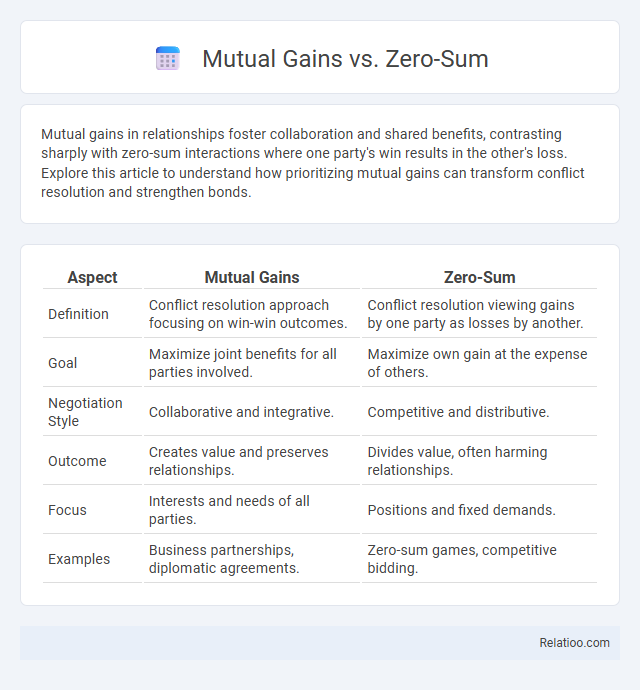Mutual gains in relationships foster collaboration and shared benefits, contrasting sharply with zero-sum interactions where one party's win results in the other's loss. Explore this article to understand how prioritizing mutual gains can transform conflict resolution and strengthen bonds.
Table of Comparison
| Aspect | Mutual Gains | Zero-Sum |
|---|---|---|
| Definition | Conflict resolution approach focusing on win-win outcomes. | Conflict resolution viewing gains by one party as losses by another. |
| Goal | Maximize joint benefits for all parties involved. | Maximize own gain at the expense of others. |
| Negotiation Style | Collaborative and integrative. | Competitive and distributive. |
| Outcome | Creates value and preserves relationships. | Divides value, often harming relationships. |
| Focus | Interests and needs of all parties. | Positions and fixed demands. |
| Examples | Business partnerships, diplomatic agreements. | Zero-sum games, competitive bidding. |
Understanding Mutual Gains and Zero-Sum Approaches
Understanding Mutual Gains involves recognizing that negotiations can create value for all parties through collaboration and shared interests, leading to outcomes that benefit everyone. In contrast, Zero-Sum approaches assume that one party's gain is another's loss, emphasizing competition and fixed resources where your success directly reduces the other party's. Embracing Mutuality fosters long-term relationships by balancing cooperation and competition, but truly understanding Mutual Gains versus Zero-Sum dynamics equips you to negotiate more strategically and achieve better results.
Key Principles of Mutual Gains Negotiation
Mutual Gains Negotiation centers on expanding the value for all parties by emphasizing collaboration, transparent communication, and understanding interests rather than positions, distinguishing it from zero-sum approaches where one party's gain equals another's loss. Key principles include separating people from the problem, focusing on interests instead of positions, generating options for mutual benefit, and using objective criteria to make decisions fair and sustainable. This approach fosters long-term relationships and mutuality by creating agreements that satisfy the underlying needs of all stakeholders involved.
Core Characteristics of Zero-Sum Mindset
The zero-sum mindset centers on the belief that one party's gain inherently results in another's loss, emphasizing competition and limited resources. Core characteristics include a fixed-pie assumption, adversarial attitudes, and a focus on short-term outcomes rather than collaborative solutions. This approach contrasts with mutual gains and mutuality, which prioritize shared benefits and long-term relationships.
Historical Context: Evolution of Negotiation Strategies
Negotiation strategies have evolved from zero-sum approaches--a mindset where one party's gain equals another's loss--rooted in early economic and military conflicts, to mutual gains strategies emerging in the 20th century that emphasize collaborative value creation. Historical shifts, such as the rise of interest-based bargaining in labor relations during the 1960s, highlight the transition toward mutuality, where Your goal is sustained partnerships and joint problem-solving rather than simple win-lose outcomes. Understanding this progression reveals how negotiation frameworks now prioritize long-term relationships and integrative solutions over fixed pie division.
Benefits of the Mutual Gains Method
The Mutual Gains method emphasizes collaborative problem-solving where all parties achieve better outcomes, contrasting sharply with the Zero-Sum approach that views negotiation as a win-lose scenario. By fostering open communication and trust, Mutual Gains create value and innovative solutions that satisfy multiple interests simultaneously. This approach enhances long-term relationships, reduces conflicts, and drives sustainable agreements through shared benefits and mutual understanding.
Drawbacks of Zero-Sum Tactics in Conflict Resolution
Zero-sum tactics in conflict resolution often lead to entrenched positions where one party's gain directly results in another's loss, fostering hostility and reducing collaboration potential. This adversarial approach can escalate conflicts and hinder long-term relationship building, as parties focus on winning rather than finding integrative solutions. In contrast, mutual gains and mutuality strategies encourage cooperative problem-solving that maximizes shared benefits and sustainable agreements.
Practical Applications: Business and Diplomacy
Mutual gains emphasize creating value in negotiations by addressing the interests of all parties, leading to collaborative solutions crucial for business partnerships and diplomatic agreements. Zero-sum approaches view negotiations as win-lose scenarios, often resulting in competitive strategies that can damage long-term relationships in both corporate deals and international diplomacy. Your ability to apply mutuality fosters trust and sustainable outcomes by balancing cooperation and competition in complex negotiations.
Psychological Factors Influencing Negotiation Styles
Psychological factors such as trust, empathy, and cognitive biases significantly influence negotiation styles, distinguishing Mutual Gains, Zero-Sum, and Mutuality approaches. Your ability to recognize others' interests fosters Mutual Gains negotiations, promoting collaborative solutions and shared value creation, while Zero-Sum negotiation often arises from competitive mindsets fueled by fear of loss or power imbalances. In contrast, Mutuality emphasizes long-term relationships and mutual respect, driven by psychological needs for connection and fairness, shaping more cooperative and integrative negotiation behaviors.
Case Studies: Mutual Gains vs Zero-Sum Outcomes
Case studies in negotiation highlight that mutual gains approaches foster collaborative solutions benefiting all parties, contrasting sharply with zero-sum tactics that produce winners and losers, often escalating conflicts. For example, in the landmark Camp David Accords, negotiators applied mutual gains strategies to achieve lasting peace between Egypt and Israel, demonstrating how integrative bargaining expands value. Conversely, zero-sum outcomes in labor disputes frequently lead to strikes and long-term distrust, underscoring the limitations of competitive negotiation models.
Choosing the Right Approach: Factors and Recommendations
Choosing the right approach between mutual gains, zero-sum, and mutuality depends on the context of stakeholder relationships, the level of trust, and the potential for shared value creation. Mutual gains strategies are recommended when collaboration, long-term partnerships, and win-win outcomes are prioritized, while zero-sum approaches may be necessary in highly competitive, limited-resource scenarios. Emphasizing mutuality fosters sustainable cooperation by balancing individual interests with collective benefits, making it ideal for complex negotiations requiring ongoing engagement and value alignment.

Infographic: Mutual Gains vs Zero-Sum
 relatioo.com
relatioo.com